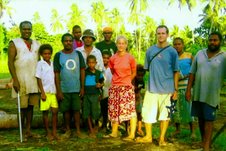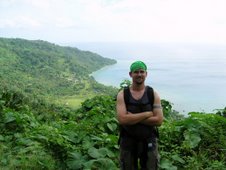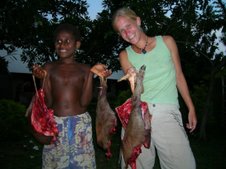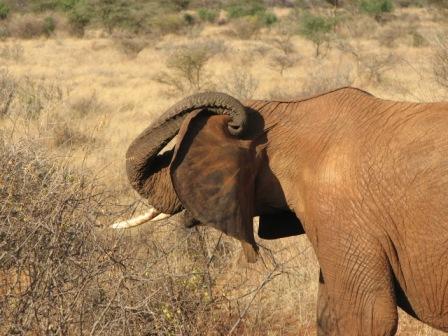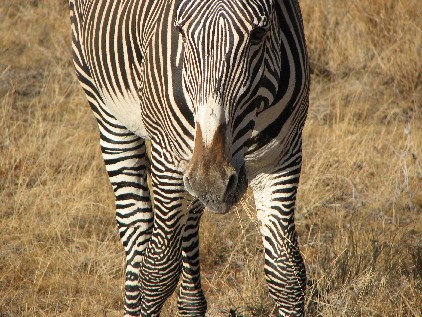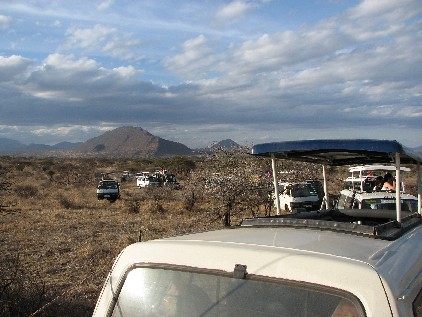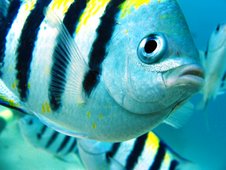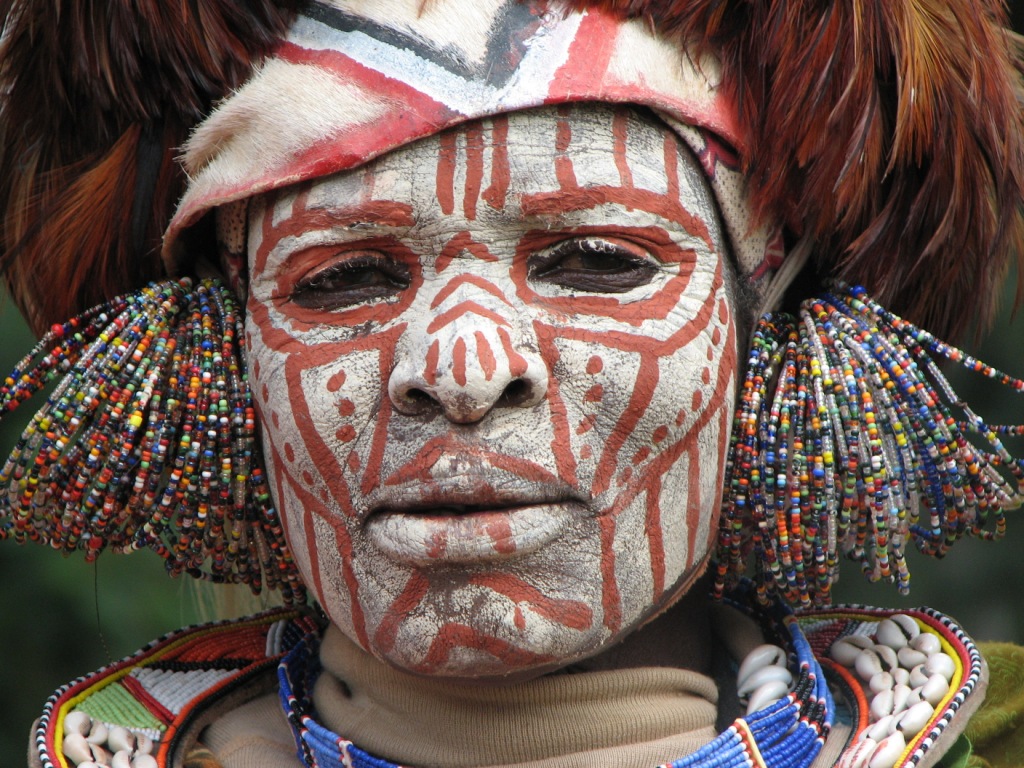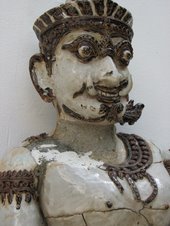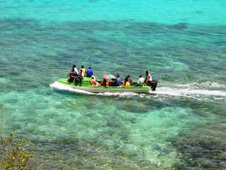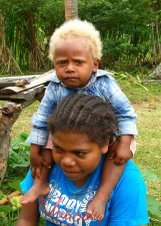 In February I got an opportunity to visit the island of monster eels, a volcano guarded crater lake, large stone relics and basins, a one hundred and twenty meter waterfall and nalat knives. Gaua is an island within the northern most province of Vanuatu, TORBA and consist of two groups of islands including the Banks islands and the most remote islands in Vanuatu, the Torres Islands. I travelled to Gaua to conduct a Reef Check training with 16 local men in the southeastern area of island. The island is one has a rugged geography and a genial demography, the hills steep and sharp, the people warm and friendly. The island is also going through a period of re-population following a history that mirrors many colonized by foreign germs and gents.
In February I got an opportunity to visit the island of monster eels, a volcano guarded crater lake, large stone relics and basins, a one hundred and twenty meter waterfall and nalat knives. Gaua is an island within the northern most province of Vanuatu, TORBA and consist of two groups of islands including the Banks islands and the most remote islands in Vanuatu, the Torres Islands. I travelled to Gaua to conduct a Reef Check training with 16 local men in the southeastern area of island. The island is one has a rugged geography and a genial demography, the hills steep and sharp, the people warm and friendly. The island is also going through a period of re-population following a history that mirrors many colonized by foreign germs and gents. Central to Gaua lore and lure is Mt. Garet, a 797 meter peak with a semi-active volcanic outgrowth at 682 meters and a 6 X 9 km crater lake, which spill over into a 120 meter water fall. Not to shabby! The crater lake, known as Lake Letas, is the not only the largest freshwater lake in Vanuatu but in all the south Pacific island countries outside of Papua New Guinea. The volcano is considered the most dangerous in Vanuatu, as there are few spare meters of rock separating the magma chamber and the water held in Lake Letas, a bit of moving and shaking could cause the next Krakatoa. The waters near the lake are said to smell of the sulphurous mud around it and always stay near the boiling point. Six kilometers away, on the eastern shore where my new Gaua friends and some Peace Corps volunteers relaxed the waters are cool, calm and have freshwater prawns and eels. The waterfall is equally, if not more impressive (I mean here in Vanuatu volcanoes are kind of an every-other-island-thing), is Siri or Siriti Falls which is fed by not only the overflow of the lake but also groundwater springs as well. These features are just the terrestrial wonders, there is also an amazing marine environment to experience which was the reason for my travels to this remote island.
outgrowth at 682 meters and a 6 X 9 km crater lake, which spill over into a 120 meter water fall. Not to shabby! The crater lake, known as Lake Letas, is the not only the largest freshwater lake in Vanuatu but in all the south Pacific island countries outside of Papua New Guinea. The volcano is considered the most dangerous in Vanuatu, as there are few spare meters of rock separating the magma chamber and the water held in Lake Letas, a bit of moving and shaking could cause the next Krakatoa. The waters near the lake are said to smell of the sulphurous mud around it and always stay near the boiling point. Six kilometers away, on the eastern shore where my new Gaua friends and some Peace Corps volunteers relaxed the waters are cool, calm and have freshwater prawns and eels. The waterfall is equally, if not more impressive (I mean here in Vanuatu volcanoes are kind of an every-other-island-thing), is Siri or Siriti Falls which is fed by not only the overflow of the lake but also groundwater springs as well. These features are just the terrestrial wonders, there is also an amazing marine environment to experience which was the reason for my travels to this remote island.
 outgrowth at 682 meters and a 6 X 9 km crater lake, which spill over into a 120 meter water fall. Not to shabby! The crater lake, known as Lake Letas, is the not only the largest freshwater lake in Vanuatu but in all the south Pacific island countries outside of Papua New Guinea. The volcano is considered the most dangerous in Vanuatu, as there are few spare meters of rock separating the magma chamber and the water held in Lake Letas, a bit of moving and shaking could cause the next Krakatoa. The waters near the lake are said to smell of the sulphurous mud around it and always stay near the boiling point. Six kilometers away, on the eastern shore where my new Gaua friends and some Peace Corps volunteers relaxed the waters are cool, calm and have freshwater prawns and eels. The waterfall is equally, if not more impressive (I mean here in Vanuatu volcanoes are kind of an every-other-island-thing), is Siri or Siriti Falls which is fed by not only the overflow of the lake but also groundwater springs as well. These features are just the terrestrial wonders, there is also an amazing marine environment to experience which was the reason for my travels to this remote island.
outgrowth at 682 meters and a 6 X 9 km crater lake, which spill over into a 120 meter water fall. Not to shabby! The crater lake, known as Lake Letas, is the not only the largest freshwater lake in Vanuatu but in all the south Pacific island countries outside of Papua New Guinea. The volcano is considered the most dangerous in Vanuatu, as there are few spare meters of rock separating the magma chamber and the water held in Lake Letas, a bit of moving and shaking could cause the next Krakatoa. The waters near the lake are said to smell of the sulphurous mud around it and always stay near the boiling point. Six kilometers away, on the eastern shore where my new Gaua friends and some Peace Corps volunteers relaxed the waters are cool, calm and have freshwater prawns and eels. The waterfall is equally, if not more impressive (I mean here in Vanuatu volcanoes are kind of an every-other-island-thing), is Siri or Siriti Falls which is fed by not only the overflow of the lake but also groundwater springs as well. These features are just the terrestrial wonders, there is also an amazing marine environment to experience which was the reason for my travels to this remote island.  The island also is home to several large lagoon areas in which the coral gardens are as expansive and dense as any I have seen in all of Vanuatu. The Siriti lagoon communities were the the ones that requested the Reef Check training under the advisement of a large environmental program called the Landholder's Conservation Initiative Program (LCIP) which is a program that is funded by the Global Environment Fund (GEF) under the United Nations Development Program (UNDP)- sorry about the acronyms.... the development sector is saturated by them. The LCIP in Vanuatu is aiming to build local capacity to better manage their natural resources and primarily are working with terrestrial and freshwater resources and land-use planning. However the program and local facilitator, Mr. Joses Tagase, through various activities found that there was a great need to also conserve and monitor their marine resources and in particular they heavily utilized coral reef and coastal resources. The LCIP then made a request to the Reef Check Coordinator (yours truly) and the end result is that myself and a fisheries officer William Morris, got to spend 10 days on one of the most beautiful islands in Vanuatu.
The island also is home to several large lagoon areas in which the coral gardens are as expansive and dense as any I have seen in all of Vanuatu. The Siriti lagoon communities were the the ones that requested the Reef Check training under the advisement of a large environmental program called the Landholder's Conservation Initiative Program (LCIP) which is a program that is funded by the Global Environment Fund (GEF) under the United Nations Development Program (UNDP)- sorry about the acronyms.... the development sector is saturated by them. The LCIP in Vanuatu is aiming to build local capacity to better manage their natural resources and primarily are working with terrestrial and freshwater resources and land-use planning. However the program and local facilitator, Mr. Joses Tagase, through various activities found that there was a great need to also conserve and monitor their marine resources and in particular they heavily utilized coral reef and coastal resources. The LCIP then made a request to the Reef Check Coordinator (yours truly) and the end result is that myself and a fisheries officer William Morris, got to spend 10 days on one of the most beautiful islands in Vanuatu.I had sixteen community members, all men, that I trained and surveyed with over the course of  8 days and utilizing four different reef areas. They were a wonderful and enthusiastic group and it seemed that no matter how rough the seas, how long past lunch we continued to swim or how late into the afternoon kava hour we went... they had no complaint. The island of Gaua is rather cut off from basic service delivery and few government groups make it up this far to assist with projects or programs and subsequently this has made the Gauans self sufficient and motivated bunch. Since I left Gaua the Reef Check Gaua team has completed numerous surveys and rounded the island, working with landowners in over 12 communities to make awareness and collect base-line data on Gaua's rich coral reef areas. They are by far one of the most successful teams of Reef Checkers in all of Vanuatu!
8 days and utilizing four different reef areas. They were a wonderful and enthusiastic group and it seemed that no matter how rough the seas, how long past lunch we continued to swim or how late into the afternoon kava hour we went... they had no complaint. The island of Gaua is rather cut off from basic service delivery and few government groups make it up this far to assist with projects or programs and subsequently this has made the Gauans self sufficient and motivated bunch. Since I left Gaua the Reef Check Gaua team has completed numerous surveys and rounded the island, working with landowners in over 12 communities to make awareness and collect base-line data on Gaua's rich coral reef areas. They are by far one of the most successful teams of Reef Checkers in all of Vanuatu!
 8 days and utilizing four different reef areas. They were a wonderful and enthusiastic group and it seemed that no matter how rough the seas, how long past lunch we continued to swim or how late into the afternoon kava hour we went... they had no complaint. The island of Gaua is rather cut off from basic service delivery and few government groups make it up this far to assist with projects or programs and subsequently this has made the Gauans self sufficient and motivated bunch. Since I left Gaua the Reef Check Gaua team has completed numerous surveys and rounded the island, working with landowners in over 12 communities to make awareness and collect base-line data on Gaua's rich coral reef areas. They are by far one of the most successful teams of Reef Checkers in all of Vanuatu!
8 days and utilizing four different reef areas. They were a wonderful and enthusiastic group and it seemed that no matter how rough the seas, how long past lunch we continued to swim or how late into the afternoon kava hour we went... they had no complaint. The island of Gaua is rather cut off from basic service delivery and few government groups make it up this far to assist with projects or programs and subsequently this has made the Gauans self sufficient and motivated bunch. Since I left Gaua the Reef Check Gaua team has completed numerous surveys and rounded the island, working with landowners in over 12 communities to make awareness and collect base-line data on Gaua's rich coral reef areas. They are by far one of the most successful teams of Reef Checkers in all of Vanuatu! Culturally Gaua is mysterious, rich in tradition and has a sinister side of conflict both historically and contemporarily. This was illustrated very powerfully on my trip to the Banks, as it just so happened that the LCIP program manager, Joses Tagase who is from Gaua and was my host family, was struck very ill upon my arrival. Due to the fact that Vanuatu is rife with a history of "black magic," poisoning, clairvoyants and sometimes intense competition between clans, contemporary Ni-Vanuatu tend to view illness and death primarily as ill-intentioned and human induced incidents. So their first and foremost suspicions on serious illness and mysterious deaths tend to be human caused and when those possibilities are exhausted they will admit the possibility of vector borne or natural causation. This was what I witnessed during my visit as an extremely sick Joses was treated first by customary leaves and water washing, proceeded by a full on prayer and family sleep over and finally having the dispensary worker test him for malaria. This took the greater part of the week. The belief was that someone may have tried to poison Joses, possibly due to his project success or his long time desire to hold this training. This line of thinking is not backward in any way shape or form. It was an unlucky coincidence in the end as he had contracted the most serious form of malaria, cerebral malaria, but unfortunately poisoning is also a well sounded fear in the Banks islands.
Culturally Gaua is mysterious, rich in tradition and has a sinister side of conflict both historically and contemporarily. This was illustrated very powerfully on my trip to the Banks, as it just so happened that the LCIP program manager, Joses Tagase who is from Gaua and was my host family, was struck very ill upon my arrival. Due to the fact that Vanuatu is rife with a history of "black magic," poisoning, clairvoyants and sometimes intense competition between clans, contemporary Ni-Vanuatu tend to view illness and death primarily as ill-intentioned and human induced incidents. So their first and foremost suspicions on serious illness and mysterious deaths tend to be human caused and when those possibilities are exhausted they will admit the possibility of vector borne or natural causation. This was what I witnessed during my visit as an extremely sick Joses was treated first by customary leaves and water washing, proceeded by a full on prayer and family sleep over and finally having the dispensary worker test him for malaria. This took the greater part of the week. The belief was that someone may have tried to poison Joses, possibly due to his project success or his long time desire to hold this training. This line of thinking is not backward in any way shape or form. It was an unlucky coincidence in the end as he had contracted the most serious form of malaria, cerebral malaria, but unfortunately poisoning is also a well sounded fear in the Banks islands. In MALAMPA (Malekula, Ambrym, Paama) and PENAMA (Pentecost, Ambae, Maewo) many would have suspected "black magic" due to its unfortunate persistence even in today's Ni-Vanuatu society. Black magic is a very sinister way to kill someone, generally from a rival nasara (tribe), in which a customary leaves, a naikaemas (dark ceremony), and supernatural powers are utilized in the killing. In the Banks they have "Poison-men" which are simply men that are trained to use customary poisons that make their way into your food or drink. There are still poison-men in operation in many of the Banks islands and a particular man still alive in Gaua today is rumored to be responsible for over 100 deaths. So naturally, in this cultural environment, if you fall ill (especially at an inconvenient time or at the height of a success) you are going to check your enemies first. Overwhelmingly, Ni-Vanuatu are kind and benign in their intentions towards others- but as they say it only takes one rotten kumala (sweet potato) to spoil the whole basket.
In MALAMPA (Malekula, Ambrym, Paama) and PENAMA (Pentecost, Ambae, Maewo) many would have suspected "black magic" due to its unfortunate persistence even in today's Ni-Vanuatu society. Black magic is a very sinister way to kill someone, generally from a rival nasara (tribe), in which a customary leaves, a naikaemas (dark ceremony), and supernatural powers are utilized in the killing. In the Banks they have "Poison-men" which are simply men that are trained to use customary poisons that make their way into your food or drink. There are still poison-men in operation in many of the Banks islands and a particular man still alive in Gaua today is rumored to be responsible for over 100 deaths. So naturally, in this cultural environment, if you fall ill (especially at an inconvenient time or at the height of a success) you are going to check your enemies first. Overwhelmingly, Ni-Vanuatu are kind and benign in their intentions towards others- but as they say it only takes one rotten kumala (sweet potato) to spoil the whole basket. I had one day in which I wasn't teaching or surveying and I spent that day hiking with two Peace Corps volunteers, Blake and Valarie, and some Ni-Vanuatu guides up to the crater lake and down to the base of the waterfall. This was a strenuous and rewarding hike, the "dark bush," the orchids and the astonishing lake with the smoking volcano in the morning and the powerful and remote cool waters of Siri Falls in the afternoon. The lake is large and locals have canoes, special spears for the prawns and eels and a lot of kastom stories about the "devil of the lake." I really didn't pry into many of the stories because I have found it most appropriate to ask to hear the customary stories of people that you have built a relationship with. Many times in Vanuatu an outsider that inquires too much about the history and custom of an area is treated with suspicion. These are stories that are shared in time and will be part of Blake and Valarie's experiences much like the stories from Unua, Malekula are part of mine.
I had one day in which I wasn't teaching or surveying and I spent that day hiking with two Peace Corps volunteers, Blake and Valarie, and some Ni-Vanuatu guides up to the crater lake and down to the base of the waterfall. This was a strenuous and rewarding hike, the "dark bush," the orchids and the astonishing lake with the smoking volcano in the morning and the powerful and remote cool waters of Siri Falls in the afternoon. The lake is large and locals have canoes, special spears for the prawns and eels and a lot of kastom stories about the "devil of the lake." I really didn't pry into many of the stories because I have found it most appropriate to ask to hear the customary stories of people that you have built a relationship with. Many times in Vanuatu an outsider that inquires too much about the history and custom of an area is treated with suspicion. These are stories that are shared in time and will be part of Blake and Valarie's experiences much like the stories from Unua, Malekula are part of mine.Now all the way up to the lake and all the way down to the base of the waterfall, which in some areas required scaling down the roots of a cliff side nabanga (banyan tree), I was being told about the large fresh water eels that inhabit the lake and the river. "As big as the post for a house," the men kept telling me. Sounded like a fisherman's tale to me considering that in Malekula the eels only reached about two-three inches in diameter and about two feet long. Technically the eels are protected under a customary taboo in parts of the river, so it was a big disappointment for our local guide to find three tails in a small pool off to the side of the river, the result of poaching and bush processing the eels. I commented that those tip of the tails were actually quite large and my guide responded, "These were still undersized." Once we reached the base of the falls it I saw an eel that met its fate failing over the 120 meter drop- it was huge, a monster, as big as the post for a house! They also inhabit the pool in which we were meant to go swimming. I thought about the shark that I had seen approaching us earlier in the week during a Reef Check training and actually felt much more comfortable with that creature in the water than these eels which to me are unknown in behavior and undetectable in the fast moving murky water.
areas required scaling down the roots of a cliff side nabanga (banyan tree), I was being told about the large fresh water eels that inhabit the lake and the river. "As big as the post for a house," the men kept telling me. Sounded like a fisherman's tale to me considering that in Malekula the eels only reached about two-three inches in diameter and about two feet long. Technically the eels are protected under a customary taboo in parts of the river, so it was a big disappointment for our local guide to find three tails in a small pool off to the side of the river, the result of poaching and bush processing the eels. I commented that those tip of the tails were actually quite large and my guide responded, "These were still undersized." Once we reached the base of the falls it I saw an eel that met its fate failing over the 120 meter drop- it was huge, a monster, as big as the post for a house! They also inhabit the pool in which we were meant to go swimming. I thought about the shark that I had seen approaching us earlier in the week during a Reef Check training and actually felt much more comfortable with that creature in the water than these eels which to me are unknown in behavior and undetectable in the fast moving murky water.
 areas required scaling down the roots of a cliff side nabanga (banyan tree), I was being told about the large fresh water eels that inhabit the lake and the river. "As big as the post for a house," the men kept telling me. Sounded like a fisherman's tale to me considering that in Malekula the eels only reached about two-three inches in diameter and about two feet long. Technically the eels are protected under a customary taboo in parts of the river, so it was a big disappointment for our local guide to find three tails in a small pool off to the side of the river, the result of poaching and bush processing the eels. I commented that those tip of the tails were actually quite large and my guide responded, "These were still undersized." Once we reached the base of the falls it I saw an eel that met its fate failing over the 120 meter drop- it was huge, a monster, as big as the post for a house! They also inhabit the pool in which we were meant to go swimming. I thought about the shark that I had seen approaching us earlier in the week during a Reef Check training and actually felt much more comfortable with that creature in the water than these eels which to me are unknown in behavior and undetectable in the fast moving murky water.
areas required scaling down the roots of a cliff side nabanga (banyan tree), I was being told about the large fresh water eels that inhabit the lake and the river. "As big as the post for a house," the men kept telling me. Sounded like a fisherman's tale to me considering that in Malekula the eels only reached about two-three inches in diameter and about two feet long. Technically the eels are protected under a customary taboo in parts of the river, so it was a big disappointment for our local guide to find three tails in a small pool off to the side of the river, the result of poaching and bush processing the eels. I commented that those tip of the tails were actually quite large and my guide responded, "These were still undersized." Once we reached the base of the falls it I saw an eel that met its fate failing over the 120 meter drop- it was huge, a monster, as big as the post for a house! They also inhabit the pool in which we were meant to go swimming. I thought about the shark that I had seen approaching us earlier in the week during a Reef Check training and actually felt much more comfortable with that creature in the water than these eels which to me are unknown in behavior and undetectable in the fast moving murky water.The waterfall's base was deafening, spray and mist enshrouded and the water fast moving and tepid compared to the river's mouth which was quite cold. You had to swim to stay in the same place and avoid entering the white water only about 20 feet away. We all swam, crossing the river to the shear-cliff face on the other side which had adequate hand and foot holds for a bit of a climb and jump session. It was amazing, the entire area encased by cliffs and the water pounding down from 120 meters above. When we began our hike home we stopped in a small village and were given Nalat by one of our guides brothers. Nalat has got to be one of my favorite and most delightful variations on the cooked-starchy stable laplap. This nalat was made of manioc (cassava) which was cooked in the traditional fashion and then bounded out by a "nalat pounder" on a large wooden dish. They then rolled the nalat into little balls and added the essential ingredient- cooked coconut flakes-derived from the boiling of coconut oil and then extracting the solid sugars that result. I started consuming with one hand and then found myself with nalat balls (plural) in each. They were a delicious end to an exhausting day, which began when the sun rose and ended after it slept behind the Gauan hills.
tepid compared to the river's mouth which was quite cold. You had to swim to stay in the same place and avoid entering the white water only about 20 feet away. We all swam, crossing the river to the shear-cliff face on the other side which had adequate hand and foot holds for a bit of a climb and jump session. It was amazing, the entire area encased by cliffs and the water pounding down from 120 meters above. When we began our hike home we stopped in a small village and were given Nalat by one of our guides brothers. Nalat has got to be one of my favorite and most delightful variations on the cooked-starchy stable laplap. This nalat was made of manioc (cassava) which was cooked in the traditional fashion and then bounded out by a "nalat pounder" on a large wooden dish. They then rolled the nalat into little balls and added the essential ingredient- cooked coconut flakes-derived from the boiling of coconut oil and then extracting the solid sugars that result. I started consuming with one hand and then found myself with nalat balls (plural) in each. They were a delicious end to an exhausting day, which began when the sun rose and ended after it slept behind the Gauan hills.
 tepid compared to the river's mouth which was quite cold. You had to swim to stay in the same place and avoid entering the white water only about 20 feet away. We all swam, crossing the river to the shear-cliff face on the other side which had adequate hand and foot holds for a bit of a climb and jump session. It was amazing, the entire area encased by cliffs and the water pounding down from 120 meters above. When we began our hike home we stopped in a small village and were given Nalat by one of our guides brothers. Nalat has got to be one of my favorite and most delightful variations on the cooked-starchy stable laplap. This nalat was made of manioc (cassava) which was cooked in the traditional fashion and then bounded out by a "nalat pounder" on a large wooden dish. They then rolled the nalat into little balls and added the essential ingredient- cooked coconut flakes-derived from the boiling of coconut oil and then extracting the solid sugars that result. I started consuming with one hand and then found myself with nalat balls (plural) in each. They were a delicious end to an exhausting day, which began when the sun rose and ended after it slept behind the Gauan hills.
tepid compared to the river's mouth which was quite cold. You had to swim to stay in the same place and avoid entering the white water only about 20 feet away. We all swam, crossing the river to the shear-cliff face on the other side which had adequate hand and foot holds for a bit of a climb and jump session. It was amazing, the entire area encased by cliffs and the water pounding down from 120 meters above. When we began our hike home we stopped in a small village and were given Nalat by one of our guides brothers. Nalat has got to be one of my favorite and most delightful variations on the cooked-starchy stable laplap. This nalat was made of manioc (cassava) which was cooked in the traditional fashion and then bounded out by a "nalat pounder" on a large wooden dish. They then rolled the nalat into little balls and added the essential ingredient- cooked coconut flakes-derived from the boiling of coconut oil and then extracting the solid sugars that result. I started consuming with one hand and then found myself with nalat balls (plural) in each. They were a delicious end to an exhausting day, which began when the sun rose and ended after it slept behind the Gauan hills. Gaua was powerful, challenging and in many aspects defies explanation. I enjoyed the trip immensely and it only solidified in my mind how rich Vanuatu is in both cultural and biological diversity. The languages, carvings, stories, dangers, histories, practices and cultural environments in Vanuatu are both derived and shared from common Melanesian explorers and yet uniquely developed to fit the diverse environmental niches created by the archipelago. Gaua is and has always been the island of monster eels and nalat knives.
Gaua was powerful, challenging and in many aspects defies explanation. I enjoyed the trip immensely and it only solidified in my mind how rich Vanuatu is in both cultural and biological diversity. The languages, carvings, stories, dangers, histories, practices and cultural environments in Vanuatu are both derived and shared from common Melanesian explorers and yet uniquely developed to fit the diverse environmental niches created by the archipelago. Gaua is and has always been the island of monster eels and nalat knives.-Jessica
